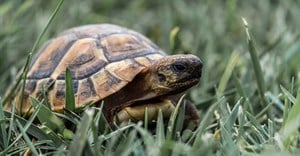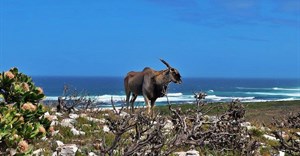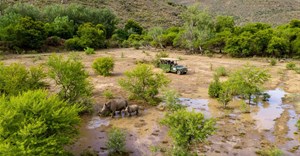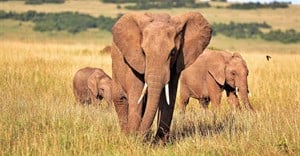Trending




 Sabre EMEA 2024 Awards: Razor PR, Retroviral top SA agenciesDanette Breitenbach
Sabre EMEA 2024 Awards: Razor PR, Retroviral top SA agenciesDanette Breitenbach
Elections 2024
#CITES: Time to re-establish balance between human, wildlife rights

During my eight years as secretary-general of CITES and, since then, as president of the International Wildlife Management Consortium (IWMC), I have never wavered in my belief that it is only viable management programmes of all the world’s wildlife and marine resources that can bring true conservation. I am also convinced that these programmes will only properly succeed if their benefits are used in favour of the livelihood of local populations. Fundamentally, I believe in restoring the balance between human beings and wildlife on planet Earth – one that I experienced as a child growing up in the Canadian wilds where I hunted and fished for food for our family.
Eco-colonialists’ capture of the conservation community
Ours is not the prevailing or even the popular view. So extensive has been the eco-colonialists’ capture of the conservation community, and so deep are their pockets and extensive their access to the media, that you seldom hear a different viewpoint in the mainstream media. Like the arrogant and paternalistic imperialists of the past, eco-colonialists believe that the environmental strictures that they have mapped out are morally superior to any other approaches; much like their religious and economic counterparts of a few hundred years ago, this excessive form of environmentalism will not hesitate to demand that national governments and international bodies support their viewpoint – or punish those countries or organisations stepping out of line.
This is precisely what happened with Zimbabwe’s Communal Areas Management Programme for Indigenous Resources (CAMPFIRE) which incorporates managed hunting as a way of generating economic benefits for local communities. In particular, through CAMPFIRE, sport hunters from the USA play a significant role in establishing a balance between local communities and elephants. This brings in much-needed income and encourages communities to regard the species as worthy of sustainable use, therefore to be respected and conserved. However since the 2014 suspension of elephant imports by the US Fish and Wildlife Service (USFWS) - after a misleading campaign in the American media - CAMPFIRE’s revenue has dropped, putting the future of this important, community-based conservation programme at real risk.
Intersection between livelihood, food security, conservation
The Zimbabwean example is particularly pertinent as CoP17 approaches, because it is an example of how the animal rights communities of the global North use their muscle to get the global South into line when it comes to wildlife trade. But the intersection between livelihood and food security, and conservation is crucially important in Southern Africa, and the many other countries in the world where the 870-million people officially designated as hungry today live.
It is for this reason that I am hoping that CoP17 supports the Draft Resolution on Livelihoods and Food Security that has been prepared by Namibia, Cote d'ivoire and Antigua & Barbuda - one of many proposals to be considered at CITES. The proposal has been prepared in line with the strategic vision of the Food and Agricultural Organization of the United Nations (FOA) and urges CoP17 to “take into account the need for inter alia, food and nutrition security, preservation of cultural identity and security of livelihoods when making proposed amendments to the Appendices”. Supporting this proposal will demonstrate that CITES understands that poverty is the biggest enemy of conservation and, we hope, will open eyes to the relationship between food security and conservation.
The Appendices
The Appendices - lists of species afforded different levels or types of trade control - are, in many ways, the most important element of CITES. In theory at least, Appendix I lists species that are threatened with extinction and permits trade only in exceptional circumstances, Appendix II lists species that are not necessarily now threatened with extinction but that may become so unless trade is closely controlled and Appendix III is a list of species included at the request of a Party that already protects a species and needs the cooperation of other countries to control trade.
IWMC believes that CoP17 affords CITES with the opportunity to support a proposal by Namibia and Zimbabwe to amend the annotation to the listing of the African elephant in Appendix II in such a way that they would be entitled to trade in ivory in accordance with the provisions of the Convention relating to the trade in Appendix II specimens. Our reasoning for this is sound. Indeed in 2007 we predicted, in a press release issued on June 14th, that the agreement made at CITES CoP14 in The Hague, to suspend trade in ivory for nine years, would undermine elephant conservation. We take no pleasure in being proved right here but it is our view that this moratorium is driving an increase in elephant poaching and illegal ivory trade. Like just about all prohibition-based initiatives in history, CITES’ much-lauded prohibition policy has therefore failed its conservation objectives of the African elephant. It has also restricted the development of human populations in the range states advocating a well-managed and controlled trade, as a tool to conserve their elephant populations.
The main successes of CITES that are usually referred to relate to species that were transferred from Appendix I to Appendix II, or maintained in the latter, to allow trade in their specimens. These include crocodilians, the vicuña and the queen conch. Why not apply the same philosophy to the African elephant as well, which is producing ivory, a very valuable resource when used properly instead of being destroyed?
By doing this, CITES will demonstrate that it is able to listen to those countries – many of them in Southern African - that have a deeper understanding of the unbreakable relationship between humans and wild species. It is people from those communities – individuals who share their living habitat with other creatures - who have the traditional scientific knowledge needed for creating programmes devoted to the sustainable use of wildlife, not the "laptop environmentalists" in London, Washington and Paris.
Celebrities, worst disease in conservation
We live in a time of sweeping statements, arguments with little or no nuance and a desire for ordinary people to “do good” in ways that don’t challenge their comfort zones. In this context it is difficult to compete with the loud, populist view that all wildlife trade should be banned. This argument taps into a well of human emotions – and also into a clutch of celebrities looking for a cause. Celebrities are the worst disease in conservation. What good is a success story like the vicuña of South America (where an endangered animal is now thriving together with legal trade in the animal’s fibre) when you have celebrities making big statements about banning all trade in wildlife? Celebrities should stick to humanitarian issues where they can make a difference, and stay out of conservation.
I would urge all South Africans, both ordinary folk and members of the conservation community, to be aware of the wolf as we head into CoP17. Be wary of those who style themselves as saviours of the planet, raising huge amounts of funding for their organisations in the process. Give celebrities who support them a wide berth. Instead, welcome the best of us in the conservation community who ask you to share your knowledge and work with us to establish programmes that benefit humans and wildlife. Most of all, make your stories known. Be brave enough to stand up and go against the prevailing view if you believe the sustainable use of wildlife will benefit your community. Both human and wildlife have rights and the time to re-establish the proper balance between the two has come.









